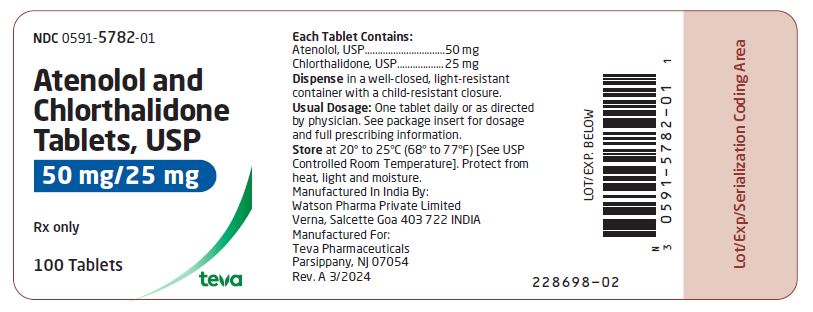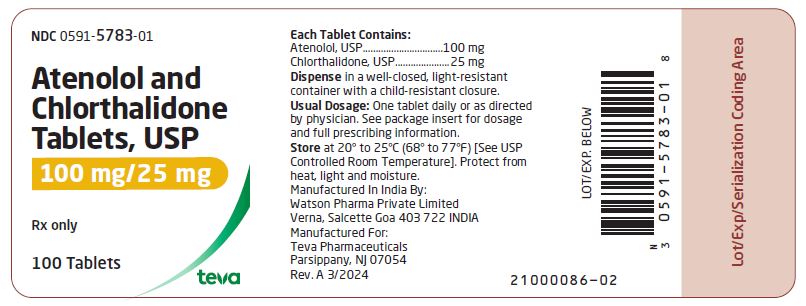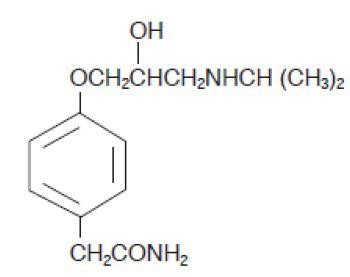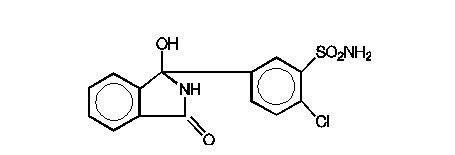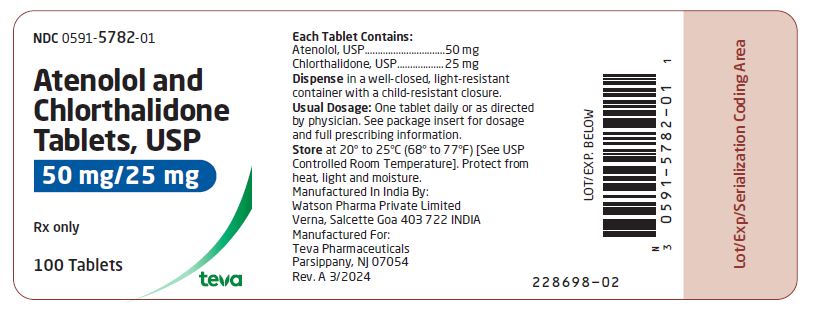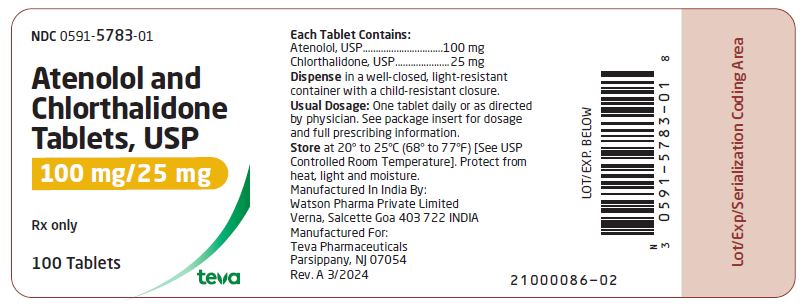General
-
Atenolol and chlorthalidone tablets may aggravate peripheral arterial circulatory disorders.
Information for Patients
-
Hypoglycemia
-
Inform patients or caregivers that there is a ...
General
Atenolol and chlorthalidone tablets may aggravate peripheral arterial circulatory disorders.
Information for Patients
Hypoglycemia
Inform patients or caregivers that there is a risk of hypoglycemia when atenolol and chlorthalidone tablets is given to patients who are fasting or who are vomiting. Monitor for symptoms of hypoglycemia.
Electrolyte and Fluid Balance Status
Periodic determination of serum electrolytes to detect possible electrolyte imbalance should be performed at appropriate intervals.
Patients should be observed for clinical signs of fluid or electrolyte imbalance; i.e., hyponatremia, hypochloremic alkalosis, and hypokalemia. Serum and urine electrolyte determinations are particularly important when the patient is vomiting excessively or receiving parenteral fluids. Warning signs or symptoms of fluid and electrolyte imbalance include dryness of the mouth, thirst, weakness, lethargy, drowsiness, restlessness, muscle pains or cramps, muscular fatigue, hypotension, oliguria, tachycardia, and gastrointestinal disturbances such as nausea and vomiting.
Measurement of potassium levels is appropriate especially in elderly patients, those receiving digitalis preparations for cardiac failure, patients whose dietary intake of potassium is abnormally low, or those suffering from gastrointestinal complaints.
Hypokalemia may develop especially with brisk diuresis, when severe cirrhosis is present, or during concomitant use of corticosteroids or ACTH.
Interference with adequate oral electrolyte intake will also contribute to hypokalemia. Hypokalemia can sensitize or exaggerate the response of the heart to the toxic effects of digitalis (e.g., increased ventricular irritability). Hypokalemia may be avoided or treated by use of potassium supplements or foods with a high potassium content.
Any chloride deficit during thiazide therapy is generally mild and usually does not require specific treatment except under extraordinary circumstances (as in liver disease or renal disease). Dilutional hyponatremia may occur in edematous patients in hot weather; appropriate therapy is water restriction rather than administration of salt except in rare instances when the hyponatremia is life-threatening. In actual salt depletion, appropriate replacement is the therapy of choice.
Drug Interactions
Atenolol and chlorthalidone may potentiate the action of other antihypertensive agents used concomitantly. Patients treated with atenolol and chlorthalidone plus a catecholamine depletor (e.g., reserpine) should be closely observed for evidence of hypotension and/or marked bradycardia which may produce vertigo, syncope or postural hypotension.
Calcium channel blockers may also have an additive effect when given with atenolol and chlorthalidone. (See WARNINGS.)
Disopyramide is a Type I antiarrhythmic drug with potent negative inotropic and chronotropic effects. Disopyramide has been associated with severe bradycardia, asystole and heart failure when administered with beta-blockers.
Amiodarone is an antiarrhythmic agent with negative chronotropic properties that may be additive to those seen with beta-blockers.
Thiazides may decrease arterial responsiveness to norepinephrine. This diminution is not sufficient to preclude the therapeutic effectiveness of norepinephrine. Thiazides may increase the responsiveness to tubocurarine.
Concomitant use of prostaglandin synthase inhibiting drugs, e.g., indomethacin, may decrease the hypotensive effects of beta-blockers.
Lithium generally should not be given with diuretics because they reduce its renal clearance and add a high risk of lithium toxicity. Read prescribing information for lithium preparations before use of such preparations with atenolol and chlorthalidone.
Beta-blockers may exacerbate the rebound hypertension which can follow the withdrawal of clonidine. If the two drugs are coadministered, the beta-blocker should be withdrawn several days before the gradual withdrawal of clonidine. If replacing clonidine by beta-blocker therapy, the introduction of beta-blockers should be delayed for several days after clonidine administration has stopped.
While taking beta-blockers, patients with a history of anaphylactic reaction to a variety of allergens may have a more severe reaction on repeated challenge, either accidental, diagnostic or therapeutic. Such patients may be unresponsive to the usual doses of epinephrine used to treat the allergic reaction.
Both digitalis glycosides and beta-blockers slow atrioventricular conduction and decrease heart rate. Concomitant use can increase the risk of bradycardia.
Other Precautions
In patients receiving thiazides, sensitivity reactions may occur with or without a history of allergy or bronchial asthma. The possible exacerbation or activation of systemic lupus erythematosus has been reported. The antihypertensive effects of thiazides may be enhanced in the postsympathectomy patient.
Carcinogenesis, Mutagenesis, Impairment of Fertility
Two long-term (maximum dosing duration of 18 or 24 months) rat studies and one long-term (maximum dosing duration of 18 months) mouse study, each employing dose levels as high as 300 mg/kg/day or 150 times the maximum recommended human antihypertensive dose*, did not indicate a carcinogenic potential of atenolol. A third (24 month) rat study, employing doses of 500 mg/kg/day and 1,500 mg/kg/day (250 and 750 times the maximum recommended human antihypertensive dose*) resulted in increased incidences of benign adrenal medullary tumors in males and females, mammary fibroadenomas in females, and anterior pituitary adenomas and thyroid parafollicular cell carcinomas in males. No evidence of a mutagenic potential of atenolol was uncovered in the dominant lethal test (mouse), in vivo cytogenetics test (Chinese hamster) or Ames test (S typhimurium).
Fertility of male or female rats (evaluated at dose levels as high as 200 mg/kg/day or 100 times the maximum recommended human dose*) was unaffected by atenolol administration.
*Based on the maximum dose of 100 mg/day in a 50 kg patient.
Animal Toxicology
Six month oral administration studies were conducted in rats and dogs using atenolol and chlorthalidone doses up to 12.5 mg/kg/day (atenolol/chlorthalidone 10/2.5 mg/kg/day –approximately five times the maximum recommended human antihypertensive dose*). There were no functional or morphological abnormalities resulting from dosing either compound alone or together other than minor changes in heart rate, blood pressure and urine chemistry which were attributed to the known pharmacologic properties of atenolol and/or chlorthalidone.
Chronic studies of atenolol performed in animals have revealed the occurrence of vacuolation of epithelial cells of Brunner’s glands in the duodenum of both male and female dogs at all tested dose levels (starting at 15 mg/kg/day or 7.5 times the maximum recommended human antihypertensive dose*) and increased incidence of atrial degeneration of hearts of male rats at 300 mg atenolol/kg/day but not 150 mg atenolol/kg/day (150 and 75 times the maximum recommended human antihypertensive dose,* respectively).
*Based on the maximum dose of 100 mg/day in a 50 kg patient.
Nursing Mothers
Atenolol is excreted in human breast milk at a ratio of 1.5 to 6.8 when compared to the concentration in plasma. Caution should be exercised when atenolol is administered to a nursing woman. Clinically significant bradycardia has been reported in breastfed infants. Premature infants, or infants with impaired renal function, may be more likely to develop adverse effects.
Neonates born to mothers who are receiving atenolol at parturition or breastfeeding may be at risk for hypoglycemia and bradycardia. Caution should be exercised when atenolol and chlorthalidone is administered during pregnancy or to a woman who is breastfeeding. (See WARNINGS, Pregnancy and Fetal Injury.)
Pediatric Use
Safety and effectiveness in pediatric patients have not been established.
Geriatric Use
Clinical studies of atenolol and chlorthalidone did not include sufficient numbers of subjects aged 65 and over to determine whether they respond differently from younger subjects. Other reported clinical experience has not identified differences in responses between the elderly and younger patients. In general, dose selection for an elderly patient should be cautious, usually starting at the low end of the dosing range, reflecting the greater frequency of decreased hepatic, renal, or cardiac function, and concomitant disease or other drug therapy.
Close

